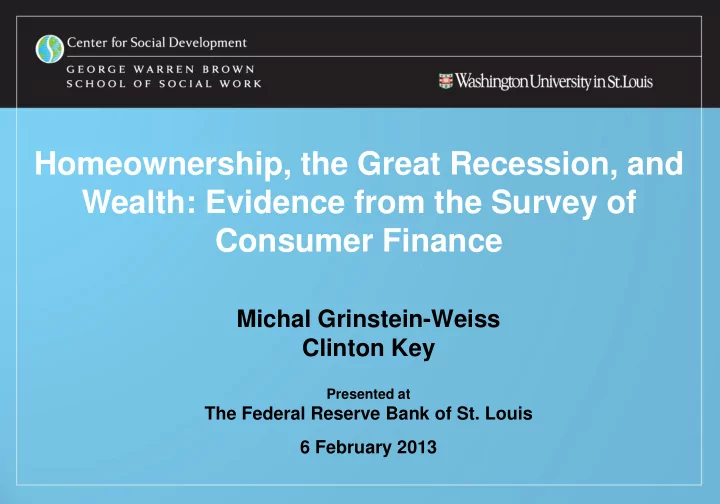

Homeownership, the Great Recession, and Wealth: Evidence from the Survey of Consumer Finance Michal Grinstein-Weiss Clinton Key Presented at The Federal Reserve Bank of St. Louis 6 February 2013
The American Dream: Homeownership • Home equity : Key component of household balance sheets • Homeownership : For most people, the largest investment of their life – Represents 60% of wealth of America’s middle -class – Among renters, 72% say owning a home is a top priority in their future plans.
Economic Benefits of Homeownership “The average wealth of homeowning households is ten times that of renter households…” — Rohe & Watson (2007) Homeowners Renters Average Wealth
Social Benefits of Homeownership • Individual : Improved life satisfaction, health outcomes • Family : Greater participation in labor force, higher education levels among children • Community : Better upkeep, more property upgrades, increased stability and civic engagement
Housing Crisis: 2006-2008 • Predatory lending • High-risk products – Low & no down-payment – Adjustable rates • Improper lending process – Fraud – Failure to document resources
Foreclosure Levels Between 2006 & 2009 Properties Filed for Foreclosure 3,000,000 2,500,000 2,000,000 1,500,000 1,000,000 500,000 0 2006 2007 2008 2009
Owning a Home – a Safe Investment? • Even in the midst of the housing crisis, home equity has remained a major part of the balance sheet. • But, many are now skeptical about homeownership as a safe investment. • This study examines wealth trajectories of distinct segments of homeowners during 2007-2009.
Present Study – Method & Analysis • Survey of Consumer Finances (SCF) • 2007 – 2009 panel • Wealth (net worth) loss or gain • Trajectories examined by homeowner segment − “ Typical homeowners ” (25 th – 75 th percentile) − Racial/ethnic category − 2007 wealth category − Renters vs. owners comparison
Characteristics of SCF data • 90% response rate • Potential follow-up response bias − Those with better trajectories might be more likely to respond. • Missing values imputed − 5 complete-information implicates • 2009 data not representative of 2009 population
Measuring Wealth in the SCF Assets Debts Liquid Checking Credit Credit cards Savings Other consumer debt Housing House value Housing Mortgage(s) Physical Other property Other physical Debt to business Business Car(s) Cars Other vehicles Other vehicles Financial Mutual funds Education Student debt CDs Savings bonds Other bonds Stocks Brokerage accts. Annuities Retirement IRA Misc. Other lines of credit 401(k) Margin loans Pension Other Misc. Life insurance Personal debt owed Business debt owed Other (Cash, valuables)
Asset-Holding Patterns by Wealth 1.000 0.900 0.800 Proportion of 2007 Assts 0.700 0.600 Miscellanious Retirement Savings 0.500 Financial Assets Physical Assets 0.400 Home value 0.300 Transaction accounts 0.200 0.100 0.000 bottom 20% middle 20% top 20% Quintile of 2007 Net Worth
Typical Household Balance Sheets In 2007 From 2007 to 2009 • Assets and debts heavily • Big decline in house concentrated in owned value home • Big decline in value of • Few financial or financial and retirement retirement assets assets • Low levels of liquid • Little change in debt assets levels
Percent Change from 2007-9, by Race 0.15 0.1 0.05 0 White Black Hispanic Other -0.05 % change in non- -0.1 equity net worth -0.15 % change in home equity -0.2 -0.25 -0.3 -0.35 -0.4
Proportion Losing Net Worth, by Race 0.7 0.6 Proportion of group 0.5 0.4 Lose net worth Lose at least 10% 0.3 Lose at least 25% Lose at least 50% 0.2 0.1 0 White Black Hispanic Other Race
Change in Net Worth 2007-2009, in U.S. Dollars 2007 to 2009 Change by 2007 Networth 50000 0 Bottom 20th-40th Middle 60th-80th top quintile quintil quintile -50000 Change in non-equity net worth -100000 Change in home equity -150000 -200000 -250000
Percentage Change in Net Worth 2007-2009 Percent change by 2007 net worth 1 0.8 0.6 0.4 0.2 % change in non-equity net worth 0 Bottom 20th-40th Middle 60th-80th top % change in net worth -0.2 quintile quintil quintile -0.4 -0.6 -0.8 -1
Wealth Mobility 2007-2009 • About 75% of households remained in same quintile • Less than 2% moved more than one quintile • Overall, despite churn of the Great Recession, relative wealth was stable
Owners vs. Renters Comparison Owners Renters Median 2007 wealth $382,890 $15,560 Median wealth change 2007 to 2009 (nominal) -$33,780 $0 Median wealth change 2007 to 2009 (percentage) -11.3% -3.0% Percentage who lost net worth 60.4% 49.0% Percentage who lost at least 10% 51.2% 45.2% Percentage who lost at least 25% 36.2% 40.3% Percentage who lost at least 50% 17.3% 32.9%
Discussion • Heterogeneity in balance sheet composition and trajectory • Home equity dominates the balance sheet before , during , and after the recession • Households with more exposure suffer bigger losses • Loss in housing value may have different implications from loss of financial assets
Discussion • Effects of the Great Recession not experienced equally across homeowner segments − Race/ethnicity − Net Worth • Some change, little mobility
Policy Implications • Housing finance and mortgage products matter • Consumer protections matter • Support may benefit historically disadvantaged populations in particular • Diversifying household’s balance sheets might reduce exposure to loss
Questions? Michal Grinstein-Weiss Center for Social Development Washington University in St. Louis michalgw@wustl.edu Clinton Key Center for Social Development University of North Carolina at Chapel Hill cckey@unc.edu
Recommend
More recommend